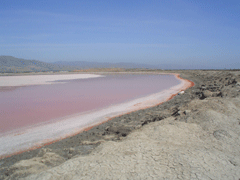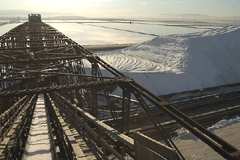Trading Salt Ponds for Salt Marshes
Air Date: Week of July 27, 2007

A high salinity pond at low tide. The pond is so salty that it actually has a layer of gypsum on it’s surface.(Photo: Andrea Kissack)
Fertile wetlands once lined the southern shore of the San Francisco Bay. But these wetlands have since been replaced by ponds used to harvest salt. Now, a collaborative effort to bring back tens of thousands of acres of those original marshes is underway. Andrea Kissack reports.
Transcript
GELLERMAN: One of the biggest and most ambitious environmental restoration projects in the country is now underway in San Francisco Bay. It will take decades and upwards of a billion dollars to turn thousands of acres of industrial salt ponds back into wetlands. As Andrea Kissack reports from San Francisco, the work is helping nature make a comeback.
KISSACK: If you’ve ever flown into San Francisco International Airport then you've seen the salt ponds. A checkerboard of orange, red and yellow hues formed by algae from high salinity levels. Go a little closer still and some of the salt ponds look like the surface of the moon: sinuous water channels flow through a layer of chalky white crust. Back in the 1800’s this former tidal marsh was diked off by levees to create ponds for salt making. In fact in some parts of the Bay, they’re still making salt, for food, medicine and road de-icing.
MOPELLI: This is our reclaim area here. This is where the salt after it’s harvested it’s been washed and it has been stacked.
KISSACK: This East Bay salt plant is owned and operated by Cargill, the Minnesota-based multinational food firm. Pat Mopelli stands dwarfed by an 80-foot high stack of salt that looks like the white top of a circus tent.

Cargill salt beds. (Courtesy of Cargill)
KISSACK: We crunch our way over a salt covered road until we reach the edge of the bay. In front of us is a surreal site, what looks like a frozen alpine lake just beginning to melt. These are Cargill’s crystallizer beds --the heart of the company’s evaporative salt making operation.
MOPELLI: You actually start to see almost what looks like ice or glassy look on the surface. As those crystals continue to grow, and they do grow, they become heavy and drop to the bottom of the crystallizer bed. And so what we are looking at is this nice even flat surface for us to be able to harvest on.
KISSACK: The water in these engineered shallow beds is going through the final stages of evaporation. The process ends here, but it actually begins out in the ponds that ring the bay.
MOPELLI: If you follow a salt molecule from the time it is pumped in from the bay through the concentration process, until it actually is precipitated out on the crystallizer, it takes on the average about four to five years.
KISSACK: Cargill sold the majority of its ponds, in 2003, to the state and federal government for 100-million dollars. Now a coalition of groups is overseeing an effort to turn 16,000 acres of former salt ponds - an area the size of Manhattan - back to natural wetlands. It’s a gargantuan effort to roll back the clock 150 years.
[AMPHIBIOUS DUMP TRUCK]
KISSACK: At the southern edge of the bay, in the Alviso Slough, near San Jose, amphibious dump trucks working on the restoration dig out mud that keeps sliding back into a channel.
MRUZ: Yeah, I can’t wait for this channel to be excavated. Basically this system has been our problem child.
KISSACK: Eric Mruz is a biologist managing the ponds for the U.S. Fish and Wildlife Service. He has been dogged by this one channel that is supposed to allow the tide to flush out a salt pond here.
MRUZ: All our water quality requirements have just been horrible for this pond. It’s because we can’t funnel enough fresh water through the system.

Cargill salt stack. Represents about a year's harvest from the crystallizer beds in the foreground. (Courtesy of Cargill)
RITCHIE: Sediment has moved into those much more than we expected. So what we are seeing out there right now are really extensive mud flats that are very rich and great feeding opportunities for a lot of shore birds. We are seeing fish come back through the channels so that fish eating birds are having a great time out there. So we really seem to see some pretty active restoration going on just now it’s just been a year since we’ve breached them.
[SEAGULL CALLS]
KISSACK: Standing on a bluff just south of the San Francisco airport, Ritchie points northwest toward Eden Landing, where another levee should be breached this fall. But with such encouraging early results, why wait so long? Ritchie says we can’t just turn it all back.
RITCHIE: We humans have changed the landscape so much that it would be irresponsible to instantly try to put it back the way it was. We would be extremely surprised and potentially have some really bad consequences we don’t want out there.
KISSACK: Like flooding. When the ponds were created the population in the Bay Area was only a few hundred thousand - far below the seven million it is now. Today, many people live or work right against the edges of the bay. In 40 years, says Ritchie, a combination of factors such as rising sea levels from climate change and a bad storm could mean disastrous flooding for Silicon Valley.
RITCHIE: Actually, what you have right behind the ponds, is you have obviously a couple of major freeways, you have the three sewage treatment plants that serve northern Santa Clara County and you have major silicon valley businesses Google, Yahoo, etc., etc. there is just many right there.

A high salinity pond at low tide. The pond is so salty that it actually has a layer of gypsum on it’s surface. (Photo: Andrea Kissack)
And then there is another challenge that has Ritchie, and others, playing Mother Nature, as they determine just which habitat will survive. It turns out, some species actually thrive on salt ponds but others don’t.
RITCHIE: California clapper rail, and salt marsh harvest mouse were the species that really utilized that area and they’ve become endangered because of the reduction in it when they were converted to salt ponds a whole lot of other species moved in, so one of the that things we have to do in terms of habitat is strike a balance between those species. We want to recover the tidal marsh area and the tidal marsh species but we don’t want to do it solely at the expense of species that like ponds.
KISSACK: If concerns such as flooding or choosing which species will survive isn’t daunting enough, how about raising a billion dollars? That’s how much restoring the more than 20 miles of shoreline could cost to complete. The task of bringing back the edges of San Francisco Bay may seem formidable but the fact that it is even possible makes many people want to try. For Living on Earth, I’m Andrea Kissack.
[MUSIC: Daniel Lanois "O Marie" from 'Arcadie' (Daniellanois.com - 2005)]
Links
Living on Earth wants to hear from you!
Living on Earth
62 Calef Highway, Suite 212
Lee, NH 03861
Telephone: 617-287-4121
E-mail: comments@loe.org
Newsletter [Click here]
Donate to Living on Earth!
Living on Earth is an independent media program and relies entirely on contributions from listeners and institutions supporting public service. Please donate now to preserve an independent environmental voice.
NewsletterLiving on Earth offers a weekly delivery of the show's rundown to your mailbox. Sign up for our newsletter today!
 Sailors For The Sea: Be the change you want to sea.
Sailors For The Sea: Be the change you want to sea.
 The Grantham Foundation for the Protection of the Environment: Committed to protecting and improving the health of the global environment.
The Grantham Foundation for the Protection of the Environment: Committed to protecting and improving the health of the global environment.
 Contribute to Living on Earth and receive, as our gift to you, an archival print of one of Mark Seth Lender's extraordinary wildlife photographs. Follow the link to see Mark's current collection of photographs.
Contribute to Living on Earth and receive, as our gift to you, an archival print of one of Mark Seth Lender's extraordinary wildlife photographs. Follow the link to see Mark's current collection of photographs.
 Buy a signed copy of Mark Seth Lender's book Smeagull the Seagull & support Living on Earth
Buy a signed copy of Mark Seth Lender's book Smeagull the Seagull & support Living on Earth

